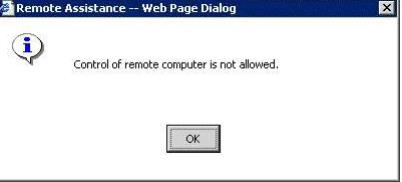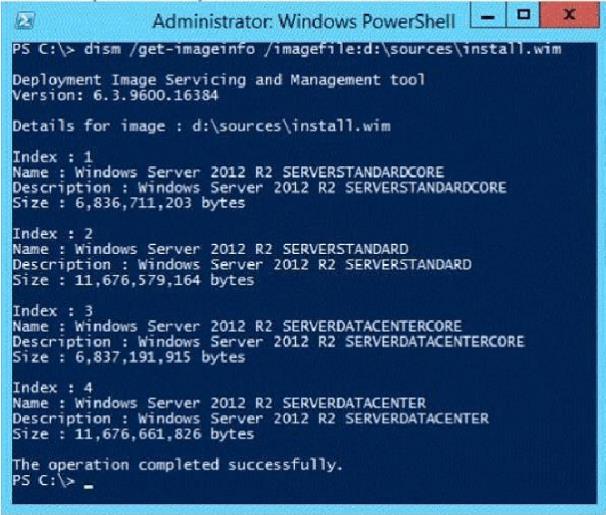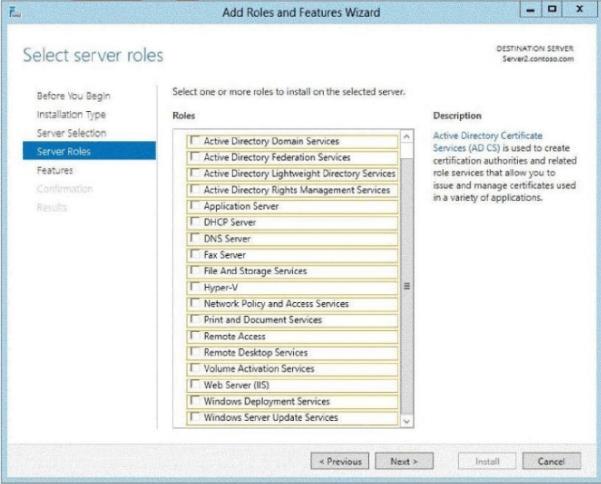You have a Web server named Server1 that runs Windows Server 2003 Service Pack 2 (SP2). Server1 hosts 100 Web sites. Each Web site uses a different application pool. You need to limit the network bandwidth for one of the Web sites. What should you do? ()
You are a network administrator for your company. All servers run Windows Server 2003.
A network server named Server1 functions as the main file server. Server1 is backed up each night by using the Backup utility. You perform a test restoration of Server1 by using the Backup utility. You discover that files that are open during the backup process are not being backed up.
You need to ensure that open files are backed up successfully.
What should you do? ()
You have a server named Server1 that runs Windows Server 2003 Service Pack 2 (SP2).
Server1 experiences a power failure and shuts down unexpectedly. You start the server and receive the following error message; “NTLDR is missing. Press Ctrl+Alt+Del to restart.”
You need to ensure that you can run Windows Server 2003 on Server1.
What should you do first? ()
You have a print server named Server1 that runs Windows Server 2003 Service Pack 2 (SP2). Server1 has a shared printer named Printer1.
You need to track the usage for Printer1. The tracked information must indicate the user that submitted the print job.
You enable auditing for object access on Server1.
What should you do next? ()
Your network contains a server named Server1 that runs Windows Server 2003 Service Pack 2 (SP2).
An administrator named Admin1 logs on to Server1. Admin1 sends you a Remote Assistance invitation.
You successfully establish a Remote Assistance session to Server1 by using the invitation.
You request control of Server1 and you receive the following error message.

You need to ensure that you can control Server1 by using Remote Assistance.
What should you instruct Admin1 to do?()
You have two servers named Server1 and Server2 that run Windows Server 2003 Service Pack 2
(SP2). Both servers have Remote Desktop disabled.
A user named User1 logs on to Server1 locally.
You log on to Server2 locally.
You need to log User1 off Server1 remotely. You must achieve this goal without restarting Server1.
Which tool should you use on Server2? ()
You have a file server named Server1 that runs Windows Server 2003 Service Pack 2 (SP2). Server1 has one basic disk that contains one partition.
You monitor the PhysicalDisk : Avg. Disk Bytes/Read counter for one year and discover that the value has decreased by 25 percent.
You need to increase the disk performance of Server1.
What should you do? ()
You have a file server named Server1 that runs Windows Server 2003 Service Pack 2 (SP2).
Shadow Copies is enabled on all volumes and daily backups are performed by using Windows Backup.
A user named User1 has a computer named Computer1 that runs Windows XP Professional Service Pack 3 (SP3).
User1 is denied the right to log on to Server1.
You need to ensure that User1 can recover previous versions of files on Server1 without help from an
administrator.
What should you do? ()

Your network contains a server named Server1 that runs Windows Server 2008 R2. You need to configure scheduled backups on Server1 to meet the following requirements:
ˆ Maintain 60 days of backups.
ˆ Minimize the performance impact on Server1 while a backup is running.
What should you do?()
Your company runs Windows Server Update Services (WSUS) on a server named Server1. Server1runs Windows Server 2008 R2. Server1 is located on the company intranet.
You configure the WSUS Web site to use SSL.
You need to configure a Group Policy object (GPO) to specify the intranet update locations.
Which URLs should you use?()
You have a server named Server1. You install Windows Server Update Services (WSUS) 3.0 on Server1. You
configure Server1 to download all updates from Microsoft Update.
Two weeks later, you notice that Server1 has not downloaded all updates.
You need to ensure that Server1 downloads all updates.
What should you do? ()
Your company has a single Active Directory forest that has an Active Directory domain named na.contoso.com. A server named Server1 runs the DNS Server server role. You notice stale resource records in the na.contoso.com zone. You have enabled DNS scavenging on Server1. Three weeks later, you notice that the stale resource records remain in na.contoso.com. You need to ensure that the stale resource records are removed from na.contoso.com.
What should you do?()
You have two servers named Server1 and Server2 that run Windows Server 2003 Service Pack
(SP2).
You connect a USB drive to Server1 and copy several files to the USB drive.
You connect the USB drive to Server2. You receive a message that the drive installed successful and is
ready-to-use.
You open Windows Explorer and the USB drive does not appear.
You need to ensure that you can access the files stored on the USB drive.
What should you do? ()
You have a file server named Server1 that runs Windows Server 2003 Service Pack (SP2).
Server1 has a 10-gigabit network adapter and is connected to a 100-Mb switch.
You replace the 100-Mb switch by using a 1-GB switch.
You discover that copying files to Server1 over the network is slow.
You need to reduce the amount of time it takes to copy files to Server1 over the network.
Which connection type should you specify for the network adapter? ()
You have a file server named Server1 that runs Windows Server 2003 Service Pack 2 (SP2).
You run a full backup of Server1, update the device driver for the network adapter, and then restart Server1.
You log on to Server1 and receive an error message that the network adapter driver failed to load.
You need to ensure that the network adapter driver starts. You must achieve this goal in the minimum amount of time.
What should you do? ()
 You review the installed features on Server1 as shown in the Features exhibit. (Click the Exhibit button.)
You review the installed features on Server1 as shown in the Features exhibit. (Click the Exhibit button.)  You need to install the Server Graphical Shell feature on Server1.Which two possible sources can you use to achieve this goal?()
You need to install the Server Graphical Shell feature on Server1.Which two possible sources can you use to achieve this goal?()
 You review the installed features on Server1 as shown in the Features exhibit. (Click the Exhibit button.)
You review the installed features on Server1 as shown in the Features exhibit. (Click the Exhibit button.)  You need to install the Server Graphical Shell feature on Server1.Which two possible sources can you use to achieve this goal?()
You need to install the Server Graphical Shell feature on Server1.Which two possible sources can you use to achieve this goal?()

You have a server named Server1 that runs Windows Server 2003 Service Pack 2 (SP2).
Server1 is configured as an enterprise root certification authority (CA).
You need to back up the CA's database and log files. You must achieve this goal by using the minimum
amount of disk space.
What should you run? ()
Your network consists of a single Active Directory domain. All servers run Windows Server 2003 Service
Pack 2 (SP2).
You have a server named Server1. Server1 is configured as an enterprise root certification authority (CA).
You perform a complete backup of Server1 that includes the system state.
Server1 fails. You install a new server named Server1.
You need to recover the enterprise root CA.
What should you do? ()
免费的网站请分享给朋友吧